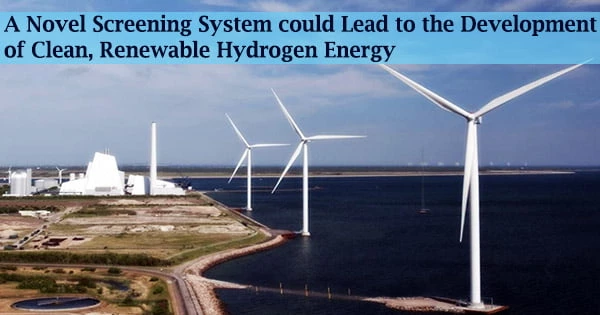According to Penn State scientists, a novel, extremely sensitive technology for detecting hydrogen gas generation could be crucial in the fight to develop hydrogen as an environmentally benign and cost-effective alternative to fossil fuels.
“We have built a new system for detecting hydrogen evolution that is the most sensitive in the world,” said Venkatraman Gopalan, professor of materials science and engineering and physics at Penn State. “This tackles a problem that had not been addressed but that is important going forward for materials discovery.”
The technique may be used to screen promising photocatalysts, which are materials that facilitate reactions that split water molecules into hydrogen and oxygen gases when placed in water and exposed to sunshine, according to the researchers.
The technique, known as water splitting, produces hydrogen in an environmentally friendly and sustainable manner, but it is inefficient, and finding the correct photocatalysts to improve hydrogen production has been difficult.
Hydrogen is the most plentiful element in the universe and the simplest element on the periodic table. For usage as an energy carrier, it must be isolated from hydrocarbons (e.g., methane CH4) or water (H2O). Renewable hydrogen energy is as straightforward as the element itself.
The researchers discovered that they could test lower amounts of photocatalyst material than ever before and detect very minute amounts of hydrogen gas created, or hydrogen evolution, in the tens of nanomoles per hour per tens of milligrams of material. Their findings were just reported in the Review of Scientific Instruments.
It’s not a brand new technology, it’s just superior engineering. The value of this is that it’s a simple, cost-effective system that anyone can build. And if they do, their research for discovering new photocatalysts is going to go much faster.
Venkatraman Gopalan
“If you ranked low in both the categories of hydrogen evolution rate and the mass of the photocatalyst needed, it means it’s a really sensitive system for discovering new photocatalytic materials,” said Huaiyu “Hugo” Wang, a graduate student in the Department of Materials Science and Engineering who led the study and built the system. “And it turns out that our work ranked the best in both categories.”
The development of photocatalysts is a hotly debated topic. Scientists lead by Ismaila Dabo, associate professor of materials science and engineering at Penn State, recently utilized a supercomputer to reduce a list of over 70,000 molecules to six potential choices.
Another team, lead by DuPont Professor of Materials Chemistry Raymond Schaak, produced the materials in their lab, but even modest volumes are expensive and time-consuming to produce.
“Typical photocatalysts use rare and precious metals such as platinum, which are immensely expensive,” said Julian Fanghanel, a graduate student in materials science and engineering who is co-advised by Dabo and Schaak. “For this project, we are making dozens of samples of materials, so making them in large quantities is impractical, time- consuming and costly.”
The new technique, according to Gopalan, will allow scientists to examine smaller quantities of these materials and concentrate their efforts on the most promising possibilities. When it came to testing samples, however, the researchers discovered that commercial equipment was insufficiently sensitive, so Gopalan and Wang constructed their own.
“They developed from the ground up a uniquely sensitive gas chromatography setup for the reproducible detection of hydrogen, which was instrumental to the validation of our computational predictions,” Dabo said. “This newly developed capability was a key enabler to confirm the discovery of new photocatalysts for the solar production of hydrogen.”
Unlike commercial machines, the novel design can evaluate photocatalysts in their raw form, according to the researchers. Photocatalysts require the use of co-catalysts and other approaches to boost their efficiency.
Titanium dioxide with platinum particles added as a co-catalyst is the gold standard, for example. Photocatalysts without these extras are referred described as “bare.”
“When we are looking at new materials, we don’t know what the correct co-catalysts will be,” Wang said. “The simple answer is detecting the bare form is the quickest way to help guide the direction of this materials discovery process.”
According to the researchers, two of the photocatalyst materials evaluated in the study performed better than titanium dioxide in its natural state. Further research into those materials could lead to potential photocatalysts, according to the findings.
“If you have a bare compound that behaved much better than titanium dioxide then we know this is a potential material to optimize,” Wang said. “If we find the right co-catalysts for those materials, we can improve them by orders or magnitude and these materials could eventually be useful in water splitting.”
The scientists claim that the system is inexpensive and simple to construct using readily available components. It has a low leakage rate and a tiny reaction chamber volume, allowing it to detect hydrogen evolution three orders of magnitude more sensitively than a traditional gas chromatography system.
“It’s not a brand new technology, it’s just superior engineering,” Gopalan said. “The value of this is that it’s a simple, cost-effective system that anyone can build. And if they do, their research for discovering new photocatalysts is going to go much faster.”
Rebecca Katz, a graduate student in Penn State’s Eberly College of Science, also contributed. The National Science Foundation supported this research.





